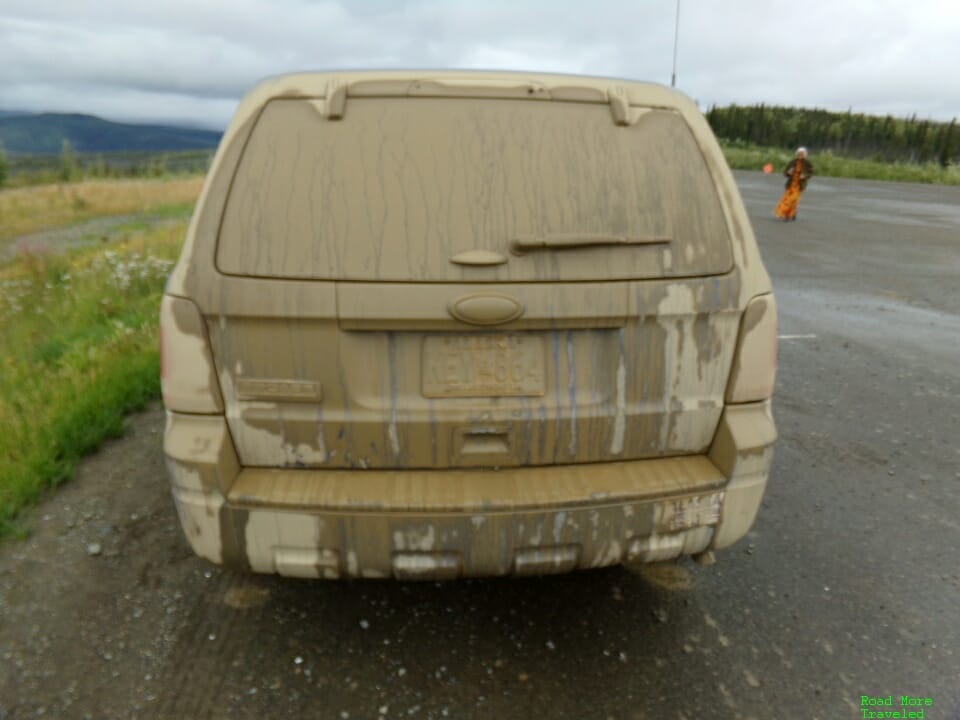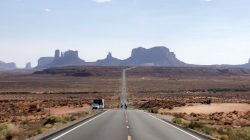Yesterday, I chronicled the ultimate American road trip, the journey on Alaska’s remote Dalton Highway.
Today, I’ll share some general advice along with road trip essentials if you’re planning your own Dalton Highway road trip.
This post is part of a larger trip report series about my trip to Alaska in August. Click here for the introductory post.
Dalton Highway Road Trip – The Basics
The Dalton Highway extends 414 miles from Livengood, about 80 miles north of Fairbanks, to Deadhorse. Although Deadhorse lies on the shores of the Arctic Ocean, the road itself stops a few miles short of the sea. Ocean access lies on private land controlled by the oil companies, and only authorized tour groups can take visitors to the coast. Well, technically only one company, the Arctic Ocean Shuttle, operated through Deadhorse Camp. The road is mostly gravel (more on that below), with a speed limit of 50 miles per hour. And yes, it really is the most remote road in America, with just two stops for food, fuel, and lodging.
One other thing to keep in mind: the trip technically stretches 495 miles; the first 81 miles are on the Steese and Elliott Highways. And with one way in and out, you’re looking at 990 miles round-trip. So budget your time accordingly and start by Renting a Recreational Vehicle.
I’ll address some major points first, before moving on to a more mile-specific guide. (Note: given the remoteness of the highway, it’s common to reference directions by “milepost”. Mileposts increase from south to north, with the end of the road at Milepost 414 in Deadhorse.) Spoiler alert: it’s not an easy drive by any means, but the “incredibly dangerous road” stuff you may read is overblown. At least in summer. Winter’s probably an entirely different story.
Pit Stops
As mentioned, between Fairbanks and Deadhorse, you’ll find a grand total of two spots to find full services. The last stop heading north out of Fairbanks is the Hilltop Truck Stop, about 16 miles north of Fairbanks in Fox. Beyond that, the next stop is Yukon River Camp, at milepost 56, 137 miles north of Fairbanks. Yukon River offers gas, a cafe, and limited lodging.

Next up is Coldfoot Camp, at milepost 175, 256 miles north of Fairbanks, also with gas, a cafe, and a motel.
11 miles beyond Coldfoot, at milepost 186, is the turnoff for Wiseman. While there is no gas available at Wiseman, there are a couple of lodging options there. But beyond that? Nada until you hit Deadhorse.
In theory, you can complete the drive from Fairbanks to Deadhorse in a single day. In good weather, you can probably make it in 13-14 hours. And hey, in summer, you’ve got 24 hours of daylight north of the Arctic Circle! I don’t, however, recommend doing so. Road conditions (more on that below) make the drive tiring despite the relatively modest distance. I recommend stopping for the night in Coldfoot or Wiseman; we stayed at Boreal Lodging in Wiseman, which was a rustic yet really nice experience. If you’re a camper, there are several campgrounds along the highway to choose from.
As for gas, it’s expensive enough as it is in Alaska, but on the Dalton, it’s another level entirely. Prices during our trip were $5.49 a gallon at Yukon River, $4.29 at Coldfoot, and $4.92 at Deadhorse. In general, here’s what I suggest for the trip:
- Fill up at Coldfoot.
- Get enough gas at Deadhorse to get you back to Coldfoot.
- Fill up with enough gas at Coldfoot to get you back to Fairbanks.
- Only top up at Yukon River if you really need to.
Most modern vehicles should be able to make the 256 miles from Fairbanks to Coldfoot without issue – but don’t take chances. If you run out of gas, a tow runs several hundred (if not thousands) of dollars. Make sure you have enough to get you to the next stop plus a few gallons. That’s especially critical in winter, when you may have to run the engine for heat in case of a storm.
Most important: there are NO groceries available outside of Fairbanks. Get any and all supplies you need for the trip out and back before leaving Fairbanks. You can sometimes find basic supplies (soda, Tylenol, etc.) in Coldfoot and Deadhorse. But you usually won’t find staples, not even cans of soup.
As for rest areas, the first appears at Yukon River, at MP 56. Thereafter, you’ll find them regularly every 20-30 miles up to Galbraith Lake (MP 275). Between there and Deadhorse, the only rest area is at MP 355. Many double as scenic viewpoints, and are well worth a stop.
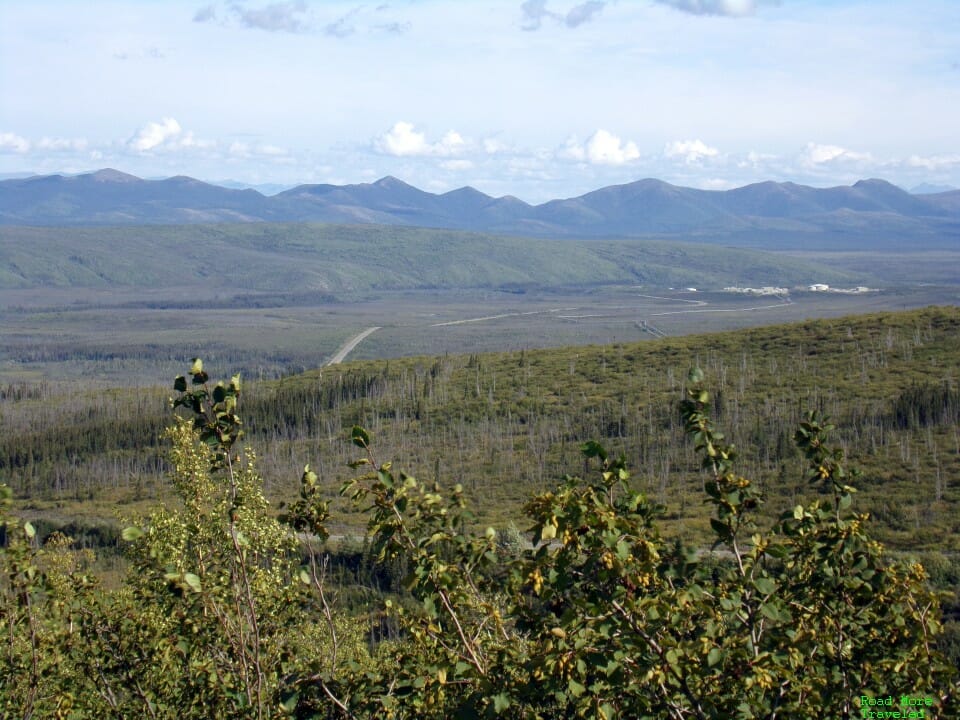
Dalton Highway Road Trip – Road Conditions
Before I start, I want to point out, most of the Dalton as of August, 2020 remains a graded gravel road. Wikipedia and other sources claim the road is paved between the following mileposts: 19-24, 37-50, 91-111, 113-197, 257-261, 344-352, and 356-361. That adds up to 139 miles of the total 414 mile highway. However, I found this largely inaccurate; I’ll provide my findings per section further below.
Simply put, prepare for just about anything. Pavement conditions can vary considerably over the span of a few miles. During our summer run, some recently graded gravel sections were remarkably smooth and easy to drive when dry. You can easily maintain 50-55 mph on these sections. Other gravel sections, though, had deteriorated badly, providing a complimentary lower lumbar adjustment on the washboard surface. Combined with large potholes, you’re lucky to average 35-40 mph, and will need to drop into the 20s at times. Usually, discolored, gray surfacing (or puddles if it rained recently) give away bad sections. Slow down and move to the other side of the road if you see one up ahead. The good news is, Alaska DOT is usually good about regrading worn down sections.

You might think paved sections provide the opportunity to put the hammer down. Guess again, though. Alaska’s harsh climate simply destroys asphalt as quickly as you can lay it down. Besides the occasion large pothole, frost heaves – basically failures in the road’s base caused by water seepage from freeze-thaw cycles – create large dips, sometimes without warning. You do NOT want to hit one of these going 70 mph. Unless you fancy destroying your suspension bushings, anyway. It’s fairly easy to spot the big dips of frost heaves ahead as long as you’re paying attention.
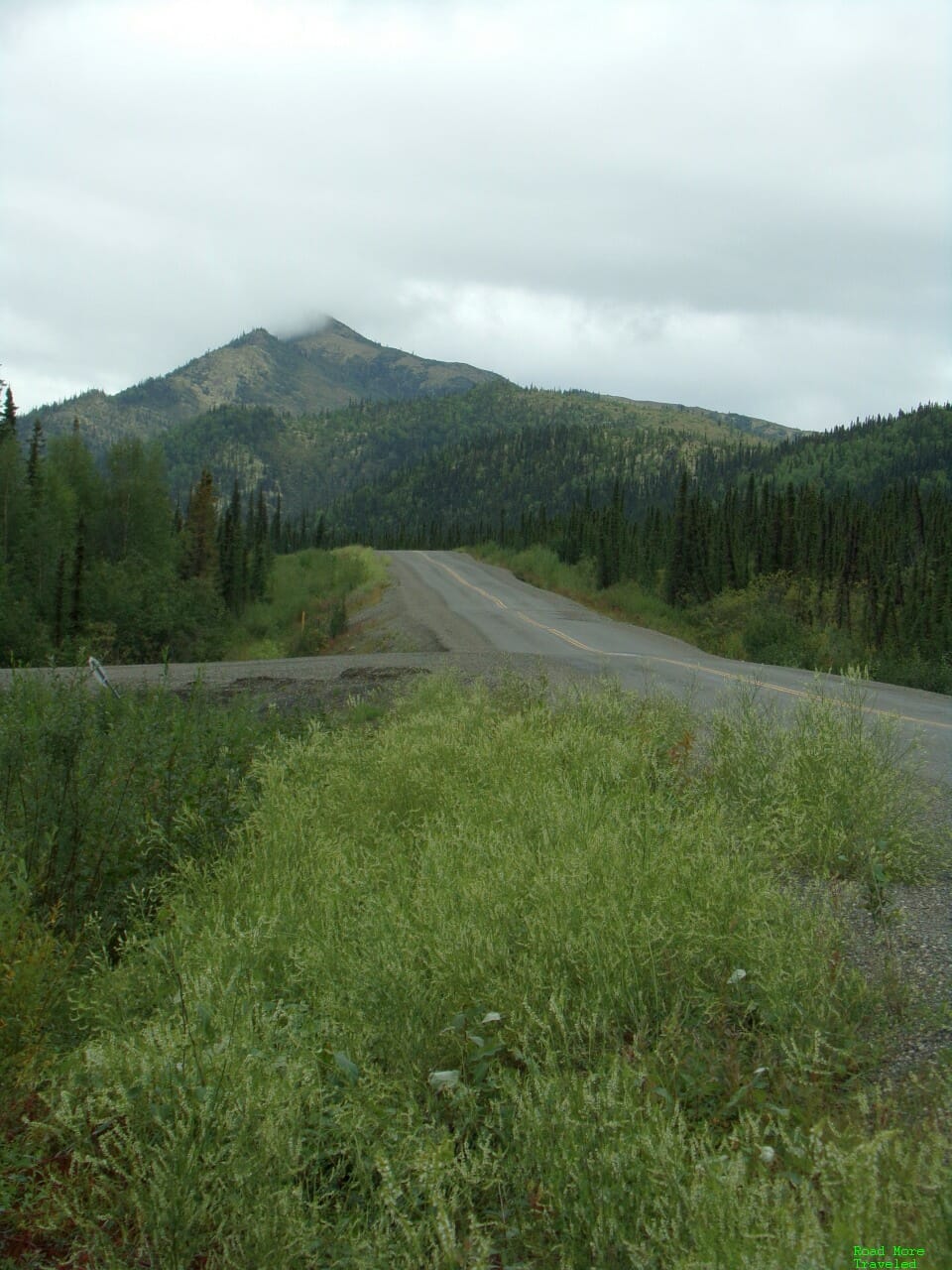
As promised, of the allegedly paved sections, I found the following ground truth:
- Mileposts 19-24 – most of the asphalt has completely washed out; there’s maybe a mile and a half remaining on the entire stretch.
- Mileposts 37-50 – fair condition with several frost heaves.
- Mileposts 91-111 – asphalt no longer exists at all. Roadway now entirely gravel, though in good condition.
- Mileposts 113-197 – asphalt no longer exists up to milepost 127. Gravel in good condition up to that point. Asphalt is in good condition from milepost 127 to about 145 (the third Jim River bridge). Road in poor condition to about milepost 171, with frequent, large potholes. Asphalt in fair condition from milepost 171 to 197; smooth but with multiple, large frost heaves.
- Milepost 197 to 209 (Dietrich turnoff) – no Dalton Highway guide I can find lists this as a paved section, but it is indeed paved. The road is in good condition here, but watch for frost heaves.
- Milepost 257-261 – pavement no longer exists; road is gravel in fair condition.
- Milepost 344-352 – asphalt in good condition.
- Milepost 356-361 – asphalt in good condition.
Note that there is currently a paving project in progress from milepost 362 to the end of the road. It’s badly needed, as the last 40 or so miles are in terrible shape, especially the northbound lane.
As a general rule – just pay attention to the road ahead of you. Take it slow when needed. That’s what I did, and I made it up and back without blowing a tire or windshield.
Dalton Highway Road Trip – Traffic and Rules of the Road
If you watched Ice Road Truckers, you’ll know the Dalton acts mostly as a “haul road” for big rigs. Roughly 100 trucks a day ply the road from Fairbanks to Deadhorse in summer; this increases to up to 200 in winter. That’s probably 75% of the traffic you’ll see. About 20% consists of hunters or fishermen, which thins out considerably north of Yukon River. And then there’s the 5% like me who are just bats*** crazy and drive the road for fun.
Some Dalton Highway guides try to scare you into thinking you’ll get frequently blown off the road by trucks. The reality is, not really. Traffic is so scarce, you just won’t encounter anyone all that often. On the entire 830 mile stretch, I needed to pass a vehicle one time. A vehicle came up in the other direction every 15-30 minutes or so. The rules of the road, though, are quite simple:
- Rule number 1: big rigs have the right of way.
- Rule number 2: when in doubt, refer to rule number 1.
If a truck comes up behind you, pull over and let them pass. Meanwhile, if you see another truck coming the opposite way, slow down, pull as far right as possible, and let them go by. Why? To save your windshield from getting blown to bits by loose gravel. You lose a few seconds by slowing to 15-20 mph to let a truck pass. But it beats paying $1,000 to the rental company for a busted windshield. Also, never stop in the middle of the road. Yes, you’ll want to take plenty of photos, but pull completely off the travel lane to do so. Big rigs can appear out of nowhere. And they’ll be less than amused at having to slam the brakes for you.
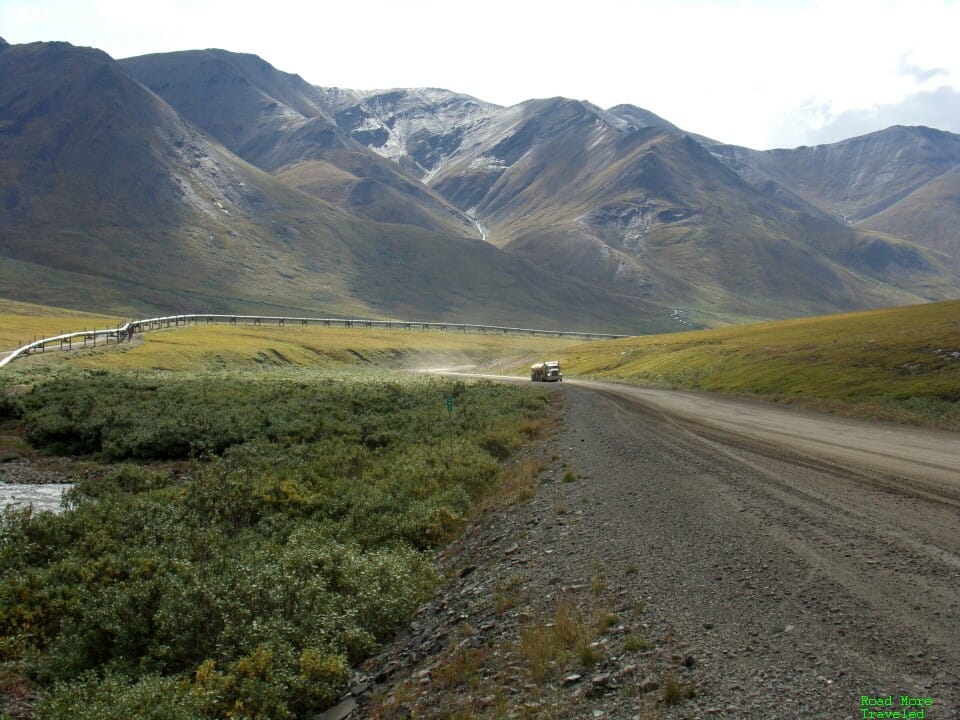
Speaking of rental companies, remember that most DO NOT allow vehicles on the Dalton. Alaska Auto Rental in Fairbanks is one of the few that rents “gravel highway vehicles”. Basically, they slap on a heavy duty windshield, puncture resistant tires, a CB radio, and a full-size spare. Gravel highway vehicles aren’t cheap; our Ford Escape AWD ran about $200 a day. But at least you don’t have to worry about violating the rental agreement.
Weather
Most tourists trying to drive the entire road visit between mid-May and mid-September. Interior Alaska is, in fact, beautiful during the summer. Late May through early July is the warmest, driest time period here. Temperatures in Fairbanks and Coldfoot routinely reach the 70s; occasional summer days even reach the 80s. Rain increases through mid-July and August, with a noticeable cooling trend. Though still pleasant, you’ll find highs in the 60s to occasionally low 70s. On the North Slope, days remain frigid until late June, with highs in the 30s. July and August occasionally bring sunny days with highs in the 50s to low 60s. However, most likely, you’ll encounter overcast skies and highs in the 40s. You can encounter snow any month of the year on Atigun Pass and in Deadhorse.
If you do encounter rain on the Dalton, prepare to get muddy. This is what my rental looked like after just 20 miles.
You see why I recommend a can of window cleaner later…
If you’re coming to see the aurora borealis, that season peaks from September through April. Beware, however, that temperatures in interior Alaska start tanking fast around Labor Day. Normal lows in Coldfoot drop below zero by Halloween, and stay there until the end of March. It’s not unusual at all to see minimum temperatures of 30-50 below zero in Fairbanks and Coldfoot any time during this period. You’ll notice a plug sticking out of your rental car’s hood; don’t forget to use it to keep your engine block from freezing solid.
And yes, summer brings the midnight sun. In fact, north of the Arctic Circle, the sun doesn’t set at all for weeks on end. In Coldfoot, the sunset-free period lasts from May 30 through July 13. Meanwhile, in Deadhorse, the sun doesn’t set for more than 2 months (May 15 – July 27). Midnight or later official sunsets occur for three months in Deadhorse, from May 6th through August 6th. And when the overcast does briefly break, it’s truly magical.
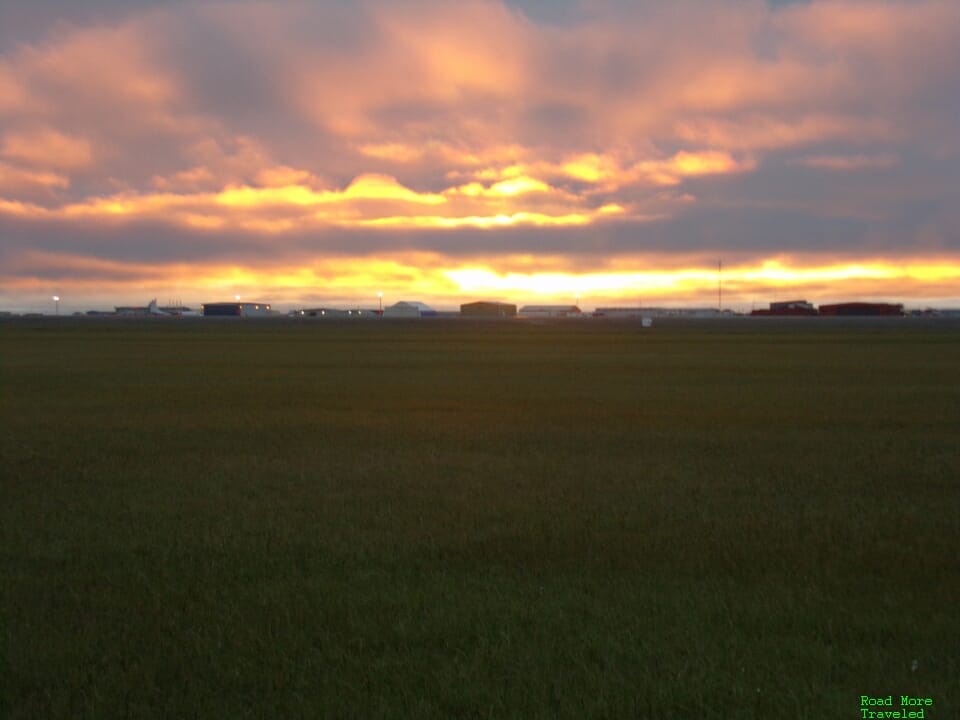
The flip side, though, is that you also encounter a sunrise-free period in winter. This only lasts a few days in December in Coldfoot (the 19th through 22nd), but for several weeks in Deadhorse (November 24 – January 16).
Miles and Points Do Not Compute, But…
Hate to break it to you, but if you’re headed up the Dalton, miles and points don’t really work. Fairbanks features a few chain hotels where you can earn or redeem points. Elsewhere, you have one hotel at Yukon River, one at Coldfoot, and a handful in both Wiseman and Deadhorse. Sorry, but your Hilton Honors, Marriott Bonvoy, or World of Hyatt points won’t get you any of those rooms. Nor will your free rental days at National, Avis, etc. get you a car that you can take up the highway just like this Revology’s 1966 Mustang convertible which is for sale.
But, you can still make miles and points work for you. Specifically, you’ll run up a substantial bill on hotels, food, and gas, and your bonus-earning credit cards do still work. If you’re paying $5 a gallon for gas, after all, might as well hope Chase Freedom offers 5x points that quarter…
The Right Vehicle and Safety Equipment
You don’t need to go overboard, but there are a few pieces of safety equipment to carry with you:
- One, but preferably two, full-size spares, mounted on rims. I made it without blowing a tire, but you want to be safe. There’s no place to repair a tire until you reach Deadhorse.
- A CB radio. This allows you to communicate with truckers and/or the Alaska State Troopers in case of problems. You can also listen in for road conditions, such as truck accidents or closures ahead.
- Water and snacks.
- A can or bottle of window cleaner, along with a roll of paper towel or pack of tissues. Trust me, you’ll thank yourself after your windows get caked with mud after 20 miles in the rain. HINT: the “Vanity Fair” napkins you can get at Safeway or Wal-Mart work well.
- Mosquito repellent. Believe me, Arctic mosquitoes are a special breed of evil.
- Toilet paper and hand sanitizer – neither are guaranteed at rest areas along the way.
Some guides recommend carrying a 5 or 10 gallon gas can. In a modern vehicle, I don’t find that necessary in summer, but would consider it in winter. Also, keep in mind that there is no cell phone service on the Elliot or Dalton Highways. You lose service a few miles out of Fairbanks; that’s it except for Coldfoot and Deadhorse. If that makes you uncomfortable, consider renting a satellite phone before leaving Fairbanks.
As for the best vehicle for the trip, I suggest a not-too-large vehicle with all-wheel drive. Alaska Auto Rental offers a Ford Escape AWD, which I found just about perfect for this trip. It’s small enough to easily maneuver, but is sure-footed even on muddy roads. If taking your own vehicle, make sure it’s in good mechanical condition before setting out. Remember, a breakdown means a very, very expensive tow back to Fairbanks.
Finally, always check the weather report before leaving Fairbanks, and again at Yukon River and Coldfoot. It’s especially important before heading through the Brooks Range past Coldfoot. Conditions can get relentlessly unforgiving through Atigun Pass and the North Slope beyond. It’s best to spend the money for a room rather than get stuck in a raging blizzard. Which, by the way, can hit anytime between September and June this far north.
How Much Time to Budget
Some drive the Dalton just to say they drove the road. Others spend several days hunting, fishing, camping, or just admiring the landscape. As a general rule, drive times between major points are:
- Fairbanks to Livengood – 1 1/2 hours
- Livengood to Yukon River – 1 1/2-2 hours
- Yukon River to Coldfoot/Wiseman – 3-4 hours
- Coldfoot/Wiseman to Deadhorse – 6 1/2 – 7 1/2 hours
If you just want to drive the whole thing in one shot, plan on 13-14 hours. We took a little longer, stopping in Wiseman the first night, spending the next day in the area, then continuing on to Deadhorse on Day 3. On the way back, we did Deadhorse to Wiseman on Day 1, then Wiseman to Fairbanks. Important: don’t let 24 hours of daylight in June and July fool you. It doesn’t make driving 14+ hours any less tiring.
Finally, before setting out, I recommend downloading the Bureau of Land Management’s georeferenced guides to the highway as a reference. I also like the Alaska Roads Dalton Highway Photo Journey for a look at the road in yeas past.



